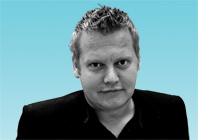2010 has been an interesting year for product development. Martyn Day takes a whistle stop tour of the last twelve months and, with good news on the horizon with regards to manufacturing, is already looking forward to 2011
After the horrendous banking induced crash we started preparing ourselves for up to a decade of general horribleness. While I am sure there will be plenty of wailing and gnashing of teeth coming our way with this Government, the amazing news is that manufacturing is actually doing well.
The BBC described our market as ‘powering ahead’ earlier this month, the CBI said we are the ‘unsung heroes’ and the Engineering Employers Federation is predicting manufacturing to outperform the rest of the economy. It’s nice to be appreciated for once!
Over the past year, in terms of design software, we have looked at the usual wide variety of modellers and analysis tools with the steady evolution of incremental releases. That said, we have also got the distinct impression that the market is shaping up for a significant change.
PTC has already announced the rebranding and merging of Pro/Engineer and its CoCreate projects under the new ‘Creo’ name tag. With the software still to be delivered this represents a serious market awareness challenge as well as a technical one, combining historybased parametric features together with direct modelling capabilities.
In fact 2010 was the year that the whole direct modelling issue reached pandemic proportions with every vendor now offering some form of direct editing technology. Before SpaceClaim came to market, direct modelling was a niche technology that didn’t seem to catch on beyond CoCreate and IronCad’s small installed bases. Now, it’s going to be in everything you own.
I think we are going to see our first cloud-based design tools come out for general use, outside of the demoware we have seen
As discussed in depth in our features section, SolidWorks is nearing the end of a massive reinvention of its core modeller, featuring Catia-level technology and running on a cloud platform.
All this sounds very ‘once upon a time’ at the moment but this is coming from both the CEO of Dassault Systèmes, Bernard Charles and the CEO of SolidWorks, Jeff Ray. In their view, CAD software is moving to be hosted on the web and will run on low-power computers, perhaps as early as next year.
Autodesk is on a similar ‘cloud’ track and Siemens says that it’s ready to compete should the market prove itself. PTC is the only firm that doesn’t feel the cloud demand. Watch this space.
Dassault Systèmes chose to give its new 2D CAD product away, saying DWG drafting is ‘free’. The software is a licensed version of Gaebert’s Ares drafting tool, which runs multi-platform (Windows, Mac, Linux). I am ot sure if this will hurt Autodesk much but hey, it’s free and legal.
Hardware
There were a number of important new products on the hardware front in 2010.
Hewlett Packard’s decision to move into 3D printing with a DesignJet 3D range now pushing the idea of rapid prototyping into the mainstream. After licensing the technology from Stratasys, the reach of HP, combined with joint marketing with the CAD developers has seen a significant increase in awareness.
In laser scanning, Faro has produced a fantastic small and light laser scanner called the Focus3D. Compared to the competition it’s up to five times smaller and has an easy iPhone-like user interface, great for scanning factories to components. While still costing over £20K this is a major step forward.
The use of powerful 3D graphics cards for tasks other than pure 3D graphics also came to the fore in 2010.
We started to see simulation software developers use Graphics Processing Units (GPUs) to calculate complex analyses and the likes of Dassault Systèmes and Autodesk are also using GPUs to accelerate ray trace rendering. With the evolution of Nvidia’s CUDA and maturation of OpenCL, the open standard, we expect much more of this in 2011.
Elsewhere within the humble workstation, while hard disks have got bigger, dealing with Terabytes, their replacements, SSD (Solid State Drives) are finally becoming affordable, although they are still limited to rating in GB.
Eventually hard drives with spinning plates will be replaced with this incredibly fast form of hard drive that has more in common with the system RAM than anything else. Most laptop manufacturers now offer these devices and we are also seeing them appear in specialist desktop workstations.
LCD Monitor technology has also benefited from the reduced cost of IPS (In-Plane Switching) technology over old TN (Twisted Nematic) panels, providing increased viewing angles and better colour reproduction.
Big monitors also cost a lot less and multimonitor set-ups have become increasingly popular with very capable and low-cost professional graphics cards.
The future – 2011
It would be churlish not to make a prediction for the coming year. If I ignore all the doom and gloom about the state of the global economy and yet more trouble from those bloody bankers, I think we are going to see our first cloud-based design tools come out for general use, outside of the demoware we have seen.
This is going to cause some excitement and may force some of the vendors to show their hands. It will be interesting to see the price and how the dealer channels are included.
We also expect increased use of the cloud to perform complex simulation and rendering calculations. All this on a backdrop of renewed competition with a buoyant manufacturing market and newly bundled software suites from all the vendors.
While it’s cold outside, things are heating up in the world of manufacturing.
Things appear to be heating up in the world of manufacturing






